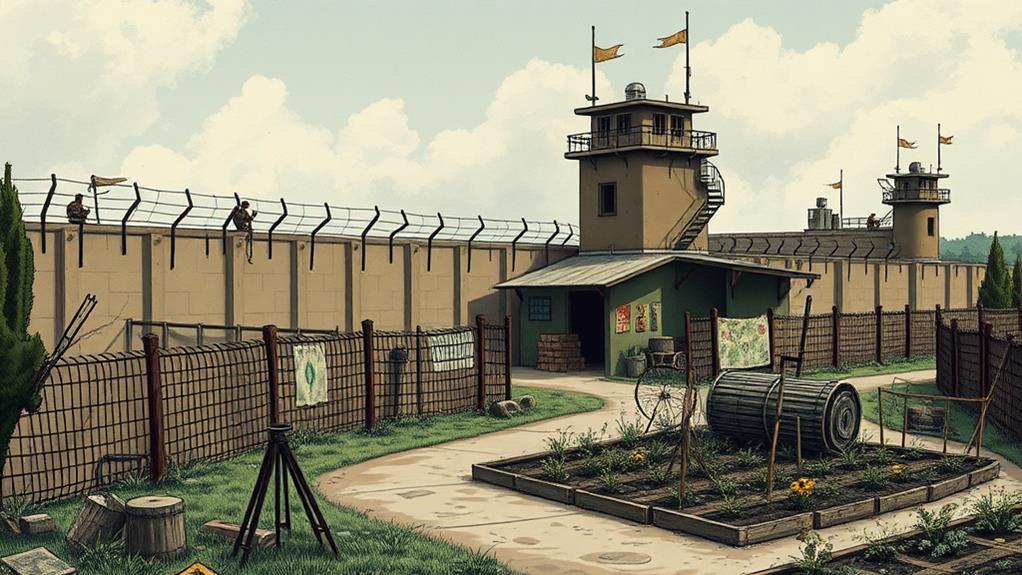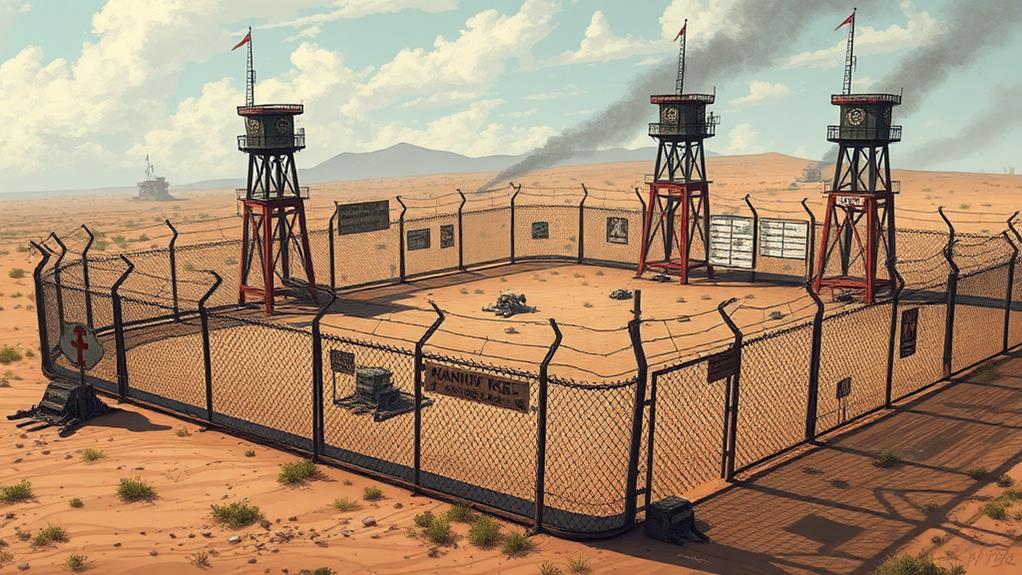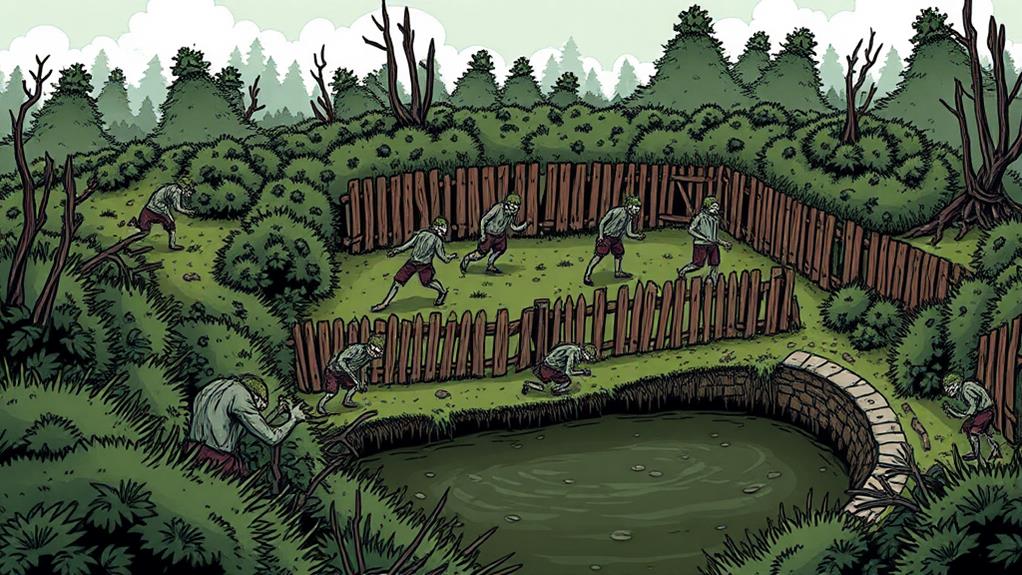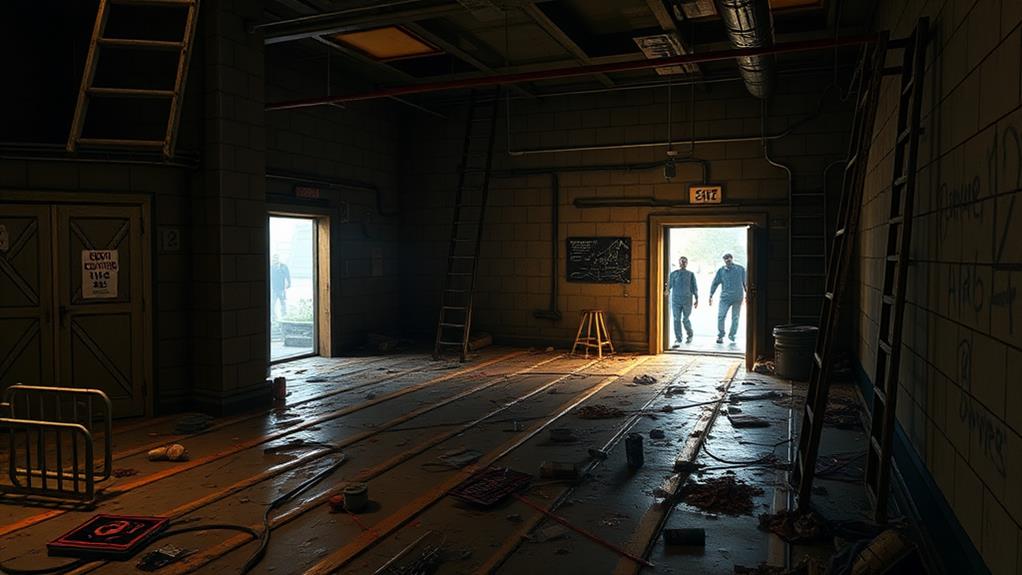
To effectively secure your safe zone from zombies, start by fortifying perimeter fences with strong materials like steel and angle the tops outward. Set up noise traps, such as tripwires tied to metal cans, to distract and disorient. Utilize natural barriers like rivers or forests to slow zombie movement. Install motion sensors at entry points paired with alarms for early detection. Always plan clear escape routes and mark them with glow-in-the-dark paint. Practicing these steps guarantees that you'll remain one step ahead of any zombie threat. Want to maximize your defenses? There are more advanced tips waiting for discovery.
Fortify Perimeter Fences

Fortifying your perimeter fences is vital for keeping zombies at bay. Start by choosing strong materials like steel or reinforced wood. These materials can withstand more force compared to regular wood or chain-link fences. Next, verify your fences are at least eight feet high to prevent zombies from climbing over them. You should also angle the top outward at about 45 degrees to further deter any climbing attempts.
Check for weak spots regularly. Walk along the perimeter daily, inspecting for damage or wear and tear. If you find any weak points, repair them immediately. Use metal braces or additional wooden planks to reinforce these sections.
Installing spikes or barbed wire along the top of the fence can serve as an additional deterrent. Zombies are less likely to attempt climbing if they risk getting impaled or tangled. Furthermore, consider adding a secondary, inner fence for an extra layer of protection. If the outer fence gets breached, this secondary barrier can buy you vital time to mount a defense.
Set Up Noise Traps
Setting up noise traps can be an effective strategy for diverting zombies away from your main living area. By creating distractions, you can lead the undead away from your safe zone, buying you and your group precious time. To start, gather materials that can produce loud, sudden noises, such as metal cans, bells, or even small radios.
Place these noise traps in areas that are far enough from your primary shelter but still within the perimeter. Tie metal cans to tripwires stretched across paths that zombies are likely to walk through. When a zombie hits the wire, the cans will clatter together, creating a noise that grabs their attention.
Alternatively, you can set up battery-operated radios on timers. Program them to switch on at intervals, emitting sounds that lure zombies toward them. This keeps the undead moving and prevents them from clustering near your safe zone.
Remember to vary the locations and types of noise traps regularly. Zombies will eventually adapt to the same tricks, so keep them guessing. With well-placed noise traps, you'll create a dynamic environment that keeps zombies on the move and away from your safe haven.
Utilize Natural Barriers

While noise traps are a great way to divert zombies, utilizing natural barriers can provide a more permanent solution. Natural barriers like rivers, cliffs, thick forests, and even steep hills can greatly hinder zombie movement, keeping your safe zone more secure without constant maintenance.
To effectively use these barriers, you need to understand their strengths and weaknesses. Here's a quick guide:
| Barrier Type | Strengths | Weaknesses |
|---|---|---|
| Rivers | Difficult for zombies to cross | May limit your movement too |
| Cliffs | Impassable for zombies | Hard to find and settle near |
| Thick Forests | Slows down zombies, provides cover | Can hide other dangers |
| Steep Hills | Physically challenging for zombies | Can be tiring for you to navigate |
| Marshlands | Traps zombies in mud | Can be treacherous for you too |
Install Motion Sensors
After setting up natural barriers to impede zombie movement, you should consider adding an extra layer of security by installing motion sensors. These devices can alert you to any undead approaching your safe zone, giving you precious time to react. Place sensors at strategic locations such as entry points, blind spots, and any weak areas in your defenses.
Motion sensors work best when paired with alarms or lights. When a sensor detects movement, it can trigger a loud noise or a bright light, startling zombies and giving you an early warning. This combination not only buys you time but also deters zombies from venturing closer. Aim to install sensors at varying heights to detect different types of movement, including crawling zombies.
Ensure your motion sensors are weatherproof and have a reliable power source, whether battery-operated or solar-powered. Regular maintenance is essential; check sensor functionality and replace batteries as needed. Integrate the sensors with your overall security system for seamless operation. By installing motion sensors, you add a vital layer of protection to your safe zone, increasing your chances of survival.
Create Escape Routes

Creating escape routes is essential for guaranteeing your survival during a zombie outbreak. You can't rely solely on fortified defenses; you also need reliable ways to exit your safe zone quickly. First, identify multiple exits from your primary shelter. These should include doors, windows, and even makeshift routes like breaking through walls if necessary.
Next, clear any obstacles that might hinder a fast escape. Remove debris, furniture, or anything else that could slow you down. It's also wise to keep these paths unobstructed at all times, as emergencies can arise without warning.
Mark your escape routes clearly. Use glow-in-the-dark paint or signs to guarantee everyone in your group knows the way, even in low light conditions. Practice drills regularly. Familiarize yourself and others with each route, so there's no confusion when the panic sets in.
Additionally, consider secondary safe zones. Identify nearby locations where you can regroup if your primary safe zone becomes compromised. Keep these areas stocked with basic supplies like water, food, and first aid kits.
At a Glance
Congratulations, you're now equipped to keep your safe zone secure. By fortifying perimeter fences, setting up noise traps, utilizing natural barriers, installing motion sensors, and creating escape routes, you'll give those unexpected guests a warm, polite "no thanks." With these tips, you're ready to maintain a peaceful and orderly haven. Remember, a little preparation goes a long way in ensuring your safety and peace of mind. Stay vigilant, stay safe, and keep those visitors at bay!






